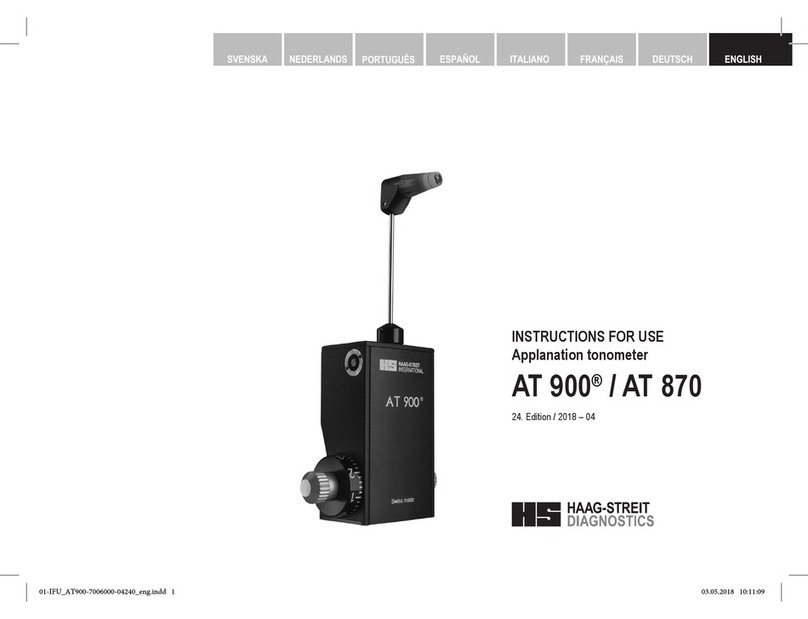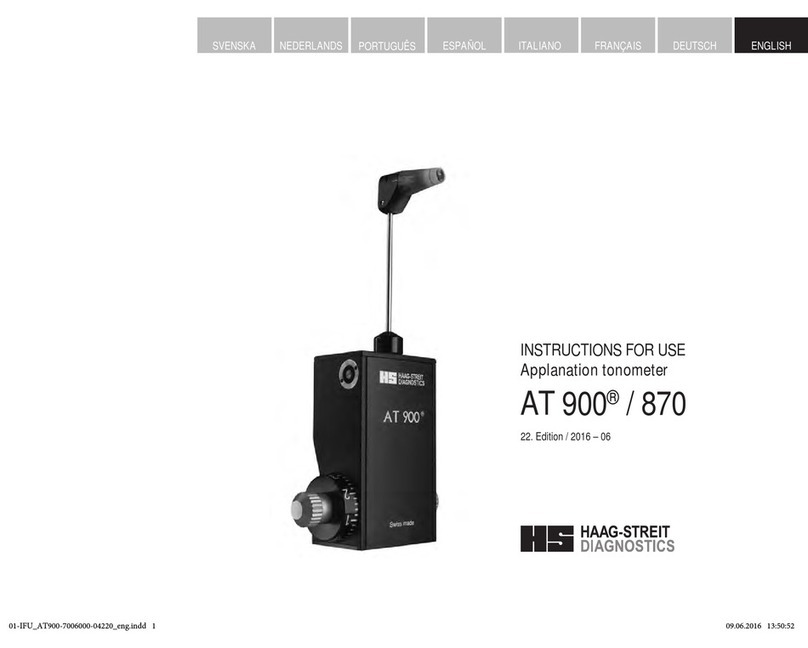
3
© HAAG-STREIT AG, 3098 Koeniz, Switzerland - HS-Doc. No. 1500.7220067.04180 – 18. Edition / 2020 – 01
DEUTSCHENGLISH FRANÇAIS ITALIANO ESPAÑOL NEDERLANDS
PORTUGUÊS SVENSKA
DEUTSCHENGLISHFRANÇAISITALIANOESPAÑOLNEDERLANDS PORTUGUÊS
SVENSKA
1. Safety ................................................................................... 4
1.1 Areas of application of the device...........................................................................4
1.2 Ambient conditions..................................................................................................4
1.3 Shipment and unpacking ........................................................................................4
1.4 Installation warnings ..............................................................................................4
1.5 Operation, environment ..........................................................................................4
1.6 Disinfection .............................................................................................................5
1.6.1 Cleaning and disinfection of the measuring prism ..................................................5
1.6.2 Visual inspection of the measuring prisms for damages.........................................5
1.6.3 Service life of reusable measuring prisms ..............................................................6
1.6.4 Tonosafe .................................................................................................................6
1.6.5 Monthly device checks............................................................................................6
1.7 Warranty and product liability..................................................................................6
1.8 Symbols ..................................................................................................................6
2. Introduction.......................................................................... 7
2.1 Overview ................................................................................................................7
2.2 System components ..............................................................................................7
2.3 Bluetooth adapter (optional)....................................................................................7
3. Appliance assembly / installation ...................................... 7
3.1 Model R...................................................................................................................7
3.2 Model T ...................................................................................................................7
3.3 Model BQ................................................................................................................7
3.4 Which slit lamp with which tonometer .....................................................................8
3.5 Description models .................................................................................................8
3.6 Magnet unit for automatic L/R detection .................................................................8
4. Commissioning.................................................................... 8
4.1 Switching the device on and off ..............................................................................9
4.2 Programming the settings .......................................................................................9
4.3 LED indicator ..........................................................................................................9
4.4 Setting the display brightness.................................................................................9
4.5 Adjusting the volume...............................................................................................9
4.6 BluetoothTM function ................................................................................................9
4.7 Battery status........................................................................................................10
5. Operation ........................................................................... 10
5.1 Measuring tips.......................................................................................................10
5.2 Astigmatism ..........................................................................................................10
5.3 How pressure is measured ...................................................................................10
5.4 Preparing the patient.............................................................................................10
5.5 Patient instructions................................................................................................10
5.6 Preparation of slit lamp and tonometer .................................................................10
5.7 Measuring correctly...............................................................................................11
5.8 Sources of error ....................................................................................................11
5.8.1 Incorrect distance to the patient ...........................................................................12
5.8.2 Position too far to the right/left ..............................................................................12
5.8.3 Position too high/low.............................................................................................13
5.8.4 Incorrect pressure.................................................................................................13
6. Software / Help menu / Error messages.......................... 13
6.1 Error messages on the tonometer display ............................................................13
7. Technical data.................................................................... 14
8. Maintenance....................................................................... 14
8.1 Repairs..................................................................................................................14
8.2 Cleaning and disinfection......................................................................................14
8.3 Checking the tonometer .......................................................................................15
8.4 Changing the battery.............................................................................................16
A. Appendix ............................................................................ 17
A.1 Accessory original HAAG‑STREIT measuring prism ............................................17
A.2 Accessory tonosafe...............................................................................................17
B. Legal regulations............................................................... 17
C. Classication ..................................................................... 17
D. Disposal ............................................................................. 17
E. Standards ........................................................................... 17
F. Information and manufacturer's declaration
regarding electromagnetic compatibility (EMC) ............ 18
F.1 General .................................................................................................................18
F.2 Emitted interference (standard table 1).................................................................18
F.3 Immunity (standard table 2) ..................................................................................19
F.4 Immunity for non‑life support devices (standard table 4) ......................................20
F.5 Safe distances for non‑life‑supporting devices (standard table 6)).......................21
Contents
01-IFU_AT900D-7220067-04180_eng.indd 301-IFU_AT900D-7220067-04180_eng.indd 3 21.01.2020 11:12:1621.01.2020 11:12:16

































